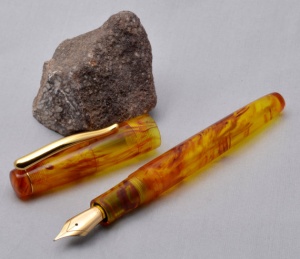Difference between revisions of "Pen Turning"
(Add link to Custom Pen Makers) |
|||
| Line 17: | Line 17: | ||
* [https://www.youtube.com/watch?v=K2LRv7cakmk Video on how to make a kitless pen on a wood lathe], Jim Hinze | * [https://www.youtube.com/watch?v=K2LRv7cakmk Video on how to make a kitless pen on a wood lathe], Jim Hinze | ||
* [http://imgur.com/a/ScQbs Photo album, step-by-step making a kitless pen], by [http://home.appalachianpens.com/2017/05/welcome-to-appalachian-pens.html Aaron Logue] | * [http://imgur.com/a/ScQbs Photo album, step-by-step making a kitless pen], by [http://home.appalachianpens.com/2017/05/welcome-to-appalachian-pens.html Aaron Logue] | ||
| + | * [https://www.youtube.com/watch?v=z30J2SjGfn4 Making of an Edison Beaumont Demonstrator], by Brian Grey | ||
=== Hardware === | === Hardware === | ||
Revision as of 00:22, 21 January 2018
A Journey into kitless fountain pen turning.
There are two major types of hand-made fountain pens: Kits, and Kitless. Kit pens are made from pre-fabricated parts, typically a brass body tube, thin metal section and nib, and metal finials. Kitless pens use a pre-made nib (or nib unit), and everything else is hand made. This article will address various factors involved in making a kitless pen.
Turning a kitless pen involves the use of a lathe (wood lathe or metal lathe) to shape the parts of the pen : Grip section, Body, and Cap. These parts are typically made from synthetic materials, including acrylics and ebonite, but some custom pen makers also use natural materials such as wood, bone, and metal.
See Custom Pen Makers for a list of pen turners making and selling pens. These makers produce custom "commissioned" pens, as well as standard models for sale, and many also sell shop "seconds".
Tutorials/How-Tos
- Tap and Dies for Kitless Pen Making, Mike Redburn
- Kitless Fountain Pen Tutorial, Shawn Newton
- some other Newton tutorials, Shawn Newton
- Kitless Pen, Fred Brunings
- Video on how to make a kitless pen on a wood lathe, Jim Hinze
- Photo album, step-by-step making a kitless pen, by Aaron Logue
- Making of an Edison Beaumont Demonstrator, by Brian Grey
Hardware
- Jowo nib unit tap/die ( M7.4 x.5 )
- Jowo nibs, fpnibs.com
- Jowo nibs, meisternibs.com
- Source for other taps and dies
- Source for other pen parts (clips, rings, etc)
Some links to sites for pen blanks/materials
- http://www.vermontfreehand.com/ (good source for ebonite rods)
- https://www.exoticblanks.com/ (tons of acrylics)
- http://www.beartoothwoods.com/catalog/index.php?cPath=22_129
- http://www.pennstateind.com/
- http://www.delviesplastics.com/
- http://www.woodturningz.com/
- https://www.classicnib.com/
- http://www.beaufortink.co.uk/
